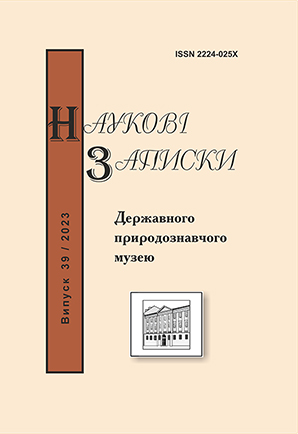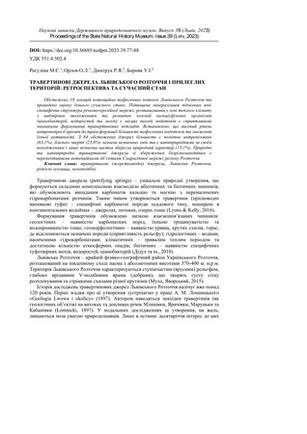Ragulina М., Оrlov О., Dmytruk R., Bornyak U.
Petrifying Springs of Lviv Roztocze and adjacent territories: the Retrospective and Modern Condition // Proc. of the State Nat. Hist. Mus. - Lviv, 2023. - 39. - P. 77-88 DOI: https://doi.org/10.36885/nzdpm.2023.39.77-88 Key words: petrifying (hard-water) springs, Lviv Roztochia, rare habitats, bryophytes Eighty-four hard-water petrifying springs of Lviv Roztocze and adjacent territories, which are forming 18 streams, were examined and their current state was assessed. The geographical position, geomorphological features, conditions of water sources and spring beds, character of tufa-forming processes, shapes of tufa formations and vegetation composition were described for each location. It was established, that travertine springs on the studied territory are related to the sources of small rivers associated with water-erosive landscape complexes. The high mineralization of groundwater, the specific structure of the river-erosion network, the location in a moisture warm climate zone, the development of colonies of calciphilic organisms (cyanobacteria, algae, bryophytes) at the watercourses led to the formation of a large travertine deposits here in the past. At the present time, the complex of natural factors is often accompanied by anthropogenic influence due to a long period of modification of the water resources of The Roztocze region. Now most of the petrifying springs are transformed by human activity, which significantly affects the intensity of tufa-forming processes. It was established, that a high level of anthropopression led to the transformation of most tufagenic watercourses and a decrease in the intensity of their activity: complete (when the processes of tufa genesis are stopped) or partial (when the processes slow downed or returned to the initial stage). Our survey of 84 sources showed that the majority of them are markedly anthropized (63.1%), about a quarter (23.8%) are lightly modified and are semi-natural in origin, and only a small part of them have a natural character now (13.1%). Among the four travertine formations known from the end of the 19th century, only two have survived (Chepin streams, Hamulets streams), while two more have been completely destroyed (Berekavitsa streams, the springhead of the Kabanivka river). It should be noted, that the active zone of tufa accumulation has noticeably decreased on 5 streams with natural or semi-natural sources (cascade on Hamulets stream, cascade on Hrybovytskyi stream, the left tributary of Chyshkivskyi stream, cascade on Chepin stream, a travertine body at the site of the bath container in Lysynytskyi stream). Tufa accumulation processes at 21 sources (25.0%) were artificially returned to the initial stage of formation due to the destruction of previously generated deposits there. Natural travertine formations of the region mainly have the form of cascades, rarely - waterfalls or crests and anthropogenic ones are mostly covered by concrete trunk. Regardless of their artificial origin, anthropogenic wells can be valuable habitats for the habitats of calciphilic bryophytes in urbanized areas. Natural and semi-natural travertine springs with saved biodiversity are can be potential objects of the Emerald network of the Roztocze region.
Petrifying Springs of Lviv Roztocze and adjacent territories: the Retrospective and Modern Condition // Proc. of the State Nat. Hist. Mus. - Lviv, 2023. - 39. - P. 77-88 DOI: https://doi.org/10.36885/nzdpm.2023.39.77-88 Key words: petrifying (hard-water) springs, Lviv Roztochia, rare habitats, bryophytes Eighty-four hard-water petrifying springs of Lviv Roztocze and adjacent territories, which are forming 18 streams, were examined and their current state was assessed. The geographical position, geomorphological features, conditions of water sources and spring beds, character of tufa-forming processes, shapes of tufa formations and vegetation composition were described for each location. It was established, that travertine springs on the studied territory are related to the sources of small rivers associated with water-erosive landscape complexes. The high mineralization of groundwater, the specific structure of the river-erosion network, the location in a moisture warm climate zone, the development of colonies of calciphilic organisms (cyanobacteria, algae, bryophytes) at the watercourses led to the formation of a large travertine deposits here in the past. At the present time, the complex of natural factors is often accompanied by anthropogenic influence due to a long period of modification of the water resources of The Roztocze region. Now most of the petrifying springs are transformed by human activity, which significantly affects the intensity of tufa-forming processes. It was established, that a high level of anthropopression led to the transformation of most tufagenic watercourses and a decrease in the intensity of their activity: complete (when the processes of tufa genesis are stopped) or partial (when the processes slow downed or returned to the initial stage). Our survey of 84 sources showed that the majority of them are markedly anthropized (63.1%), about a quarter (23.8%) are lightly modified and are semi-natural in origin, and only a small part of them have a natural character now (13.1%). Among the four travertine formations known from the end of the 19th century, only two have survived (Chepin streams, Hamulets streams), while two more have been completely destroyed (Berekavitsa streams, the springhead of the Kabanivka river). It should be noted, that the active zone of tufa accumulation has noticeably decreased on 5 streams with natural or semi-natural sources (cascade on Hamulets stream, cascade on Hrybovytskyi stream, the left tributary of Chyshkivskyi stream, cascade on Chepin stream, a travertine body at the site of the bath container in Lysynytskyi stream). Tufa accumulation processes at 21 sources (25.0%) were artificially returned to the initial stage of formation due to the destruction of previously generated deposits there. Natural travertine formations of the region mainly have the form of cascades, rarely - waterfalls or crests and anthropogenic ones are mostly covered by concrete trunk. Regardless of their artificial origin, anthropogenic wells can be valuable habitats for the habitats of calciphilic bryophytes in urbanized areas. Natural and semi-natural travertine springs with saved biodiversity are can be potential objects of the Emerald network of the Roztocze region.
References
- Бойко М.Ф. 2010. Раритетні види мохоподібних фізико-географічних рівнинних зон та гірських ландшафтних країн України. Чорномор. ботан. журн. Т. 6 № 3. С. 294–315.
- Дідух Я. П., Чорней І. І., Буджак В. В. та ін. 2018. Рідкісний туфогенний біотоп у басейні Дністра. Укр. ботан. журн. Т. 75 № 2. С. 149–159.
- Дмитрук Р., Яцишин А. 2019. Травертини заходу України – цінні пам’ятки неживої природи // Всеукр. конф. до 20-річчя кафедри екологічної та інженерної геології і гідрогеології ЛНУ імені Івана Франка «Екологічні проблеми надрокористування. Наука, освіта, практика» (19-21 вересня 2019 р., м. Львів). Збірник матеріалів. С. 40–42.
- Доброчаева Д.Н., Котов М.И., Прокудин Ю.Н. и др. 1987. Определитель высших растений Украины. Киев : Наук. думка. 548 с.
- Екологічний атлас Львівщини. 2007. За ред. Б.М. Матолича. Львів. 68 с.
- Кагало О.О., Сичак Н.М. 2003. Рідкісні, зникаючі та інші види судинних рослин Львівської області (Україна), які потребують охорони. У: Наукові основи збереження біотичної різноманітності: Зб. наук. праць. Львів : Ліга-Прес. Вип. 4. С. 47–58.
- Кагало О.О., Проць Б.Г. 2012. Оселищна концепція збереження біорізноманіття: базові документи Європейського Союзу. Львів: ЗУКЦ. 278 с.
- Кагало О.О., Омельчук О.С., Орлов О.Л., Рагуліна М.Є., Сичак Н.М. 2020. Оселищне різноманіття та його созологічна оцінка території Львівського Музею народної архітектури як приклад попереднього аналізу демутації антропогенного ландшафту. Наукові записки Державного природознавчого музею. Вип. 36. С. 107–114.
- Колодій В., Паньків Р., Манкут О. 2007. До гідрології і геохімії Львова й околиць. Праці наукового товариства імені Шевченка. Геологічний збірник. Львів. С. 175–181.
- Муха Б.П., Яворський Б.І. 2015. Ландшафтна структура. Біосферний резерват «Розточчя». Львів : ЗУКЦ. С. 68–78.
- Про оголошення гідрологічного заказника місцевого значення «Травертинові джерела»: Рішення Львівської обласної ради № 459 від 30.03.2023. URL:https://mail.lvivoblrada.gov.ua/public/vendor/adminlte/plugins/ckeditor/plugins/kcfinder-master/upload/files/Rishenay%20sesiu/8%20sklukanay/16/459.pdf
- Савка Г. 2014. Ідентифікаційні ознаки флювіальних водно-ерозійних ландшафтних комплексів Українського Розточчя // Наук.-практ. конф. «Ландшафтознавство: стан, проблеми, перспективи» (24-27 вересня 2014 р., м. Львів). Збірник матеріалів. С. 81–82.
- Шушняк В., Савка Г. 2014. Передумови та созологічна доцільність створення регіонального ландшафтного парку на приміських землях Львова. Вісник Львівського університету. Серія географічна. Вип. 45. С. 436–443.
- Яцишин А., Дмитрук Р. 2020. Елементи геотуристичної мережі Львова // Міжнар. наук.-практ. онлайн-конференція, присвячена 20-річчю кафедри конструктивної географії і картографії Львівського національного університету імені Івана Франка «Конструктивна географія і картографія: стан, проблеми, перспективи» (1‒3 жовтня 2020 р., м. Львів). Збірник матеріалів. С. 253–258.
- Bardat J., Hauguel J-C. 2002. Synopsis bryosociologique pour la France. Cryptogamie Bryologie. Vol. 23. P. 279–343.
- Beraldi-Campesi H., Arenas-Abad C., Auque-Sanz L. et al. 2016. Benthic diatoms on fluvial tufas of the Mesa River, Iberian Range, Spain. Hidrobiológica. 26(2). Р. 283–297.
- Dražina T., Špoljar M., Primc B. et al. 2013. Small-scale patterns of meiofauna in a bryophyte covered tufa barrier (Plitvice Lakes, Croatia). Limnologica. Vol. 43(6). P. 405–416.
- Farr G., Graham J. 2017. Survey, characterisation and condition assessment of Palustriella dominated springs 'H7220 Petrifying springs with tufa formation (Cratoneurion)' in Gloucestershire, England. British Geological Survey. 141 p.
- Freytet P., Plet A. 1991. Les formations stromatolitiques(tufs calcaires) récentes de la région de Tournus (Saône et Loire). Geobios. Vol. 24(2). P. 123–139.
- Guide des végétations humides et aquatiques en Pays de la Loire. URL: https://www.cbnbrest.fr/observatoire-milieux/boite-a-outils/determination-milieux/guide-zh-pdl
- Geurts M., Frappier M., Tsien H. 1992. Morphogenèse des barrages de travertin de Coal River Springs, sud-est du Territoire du Yukon. Géographie physique et Quaternaire. Vol. 46 (2). Р. 131–245.
- Hodgetts N., Söderström L., Blockeel T. et al. 2020. An annotated checklist of bryophytes of Europe, Macaronesia and Cyprus. Journal of Bryology. 42(1). Р. 1–116.
- Hugonnot V. 2017. Approche morphologique, phytocœnotique et fonctionnelle des bryolithes de la basse vallée de l’Isère (de Saint-Marcellin à Romans), France. Revue d’Ecologie. 72 (2). Р. 116–133.
- Łomnicki M. 1897. Geologia Lwowa i okolicy. Atlas geologiczny Galicyi. Zeszyt 10 czesc 1. Kraków : Wydawnictwo Fizjograficzne Akademii Um. 208 s.
- Lyons M.D., Kelly D.L. 2016. Monitoring guidelines for the assessment of petrifying springs in Ireland. Irish Wildlife Manuals. № 94. 73 p.
- Pentecost A. 1995. The quaternary travertine deposits of Europe and Asia Minor. Quaternary Science Reviews. 14(10). P. 1005-1028.
- Pentecost A., Viles H. 1994. A review and reassessment of travertine classification. Géographie physique et Quaternaire. Vol. 48(3). Р. 305–314.
- Perri E., Manzo E., Tucker M. 2012. Multi-scale study of the role of the biofilm in the formation of minerals and fabrics in calcareous tufa. Sedimentary Geology. 263-264. P. 16–29.
- Poponessi S., Aleffi M., Sabovljević M., Venanzoni R. 2020. Bryophyte diversity hotspot: the Marmore Waterfalls Regional Park (Umbria, central Italy). Italian Botanist. 10(1). Р. 33-45.
- Rainey D., Jones B. 2007. Rapid cold water formation and recrystallization of relic bryophyte tufa at the Fall Creek cold springs, Alberta, Canada. Canadian Journal of Earth Sciences. 44(7). Р. 889–909.
- Stanković I., Szabó B., Hauer T., Udovič М. 2023. Benthic Algae on Tufa Barriers. Plitvice Lakes. Springer. Р. 179–214.
- Zubel R., Danylkiv I., Rabyk I. et al. 2015. Bryophytes of the Roztocze region (Poland and Ukraine). Lublin : Libropolis. 218 p.


